Arrow Spine And Tip Weight
By Jon Henry
Arrow Spine - the 'Backbone' of the Arrow
If you've ever gone fishing, you probably already understand this concept. A fishing pole shouldn't be too limber or too stiff. You wouldn't take your heavyweight fishing-rod when you go Bluegill and Perch fishing? It's simply too stiff for the job and would perform poorly. A stiff rod doesn't cast light baits very well, and dragging in small pan fish on a heavyweight rod would be no fun anyway. On the other hand, you wouldn't dare take your ultra-lite fishing-rod for an afternoon of Florida Tarpon fishing. The ultra-lite rod wouldn't be stiff enough to fight such large fish, and it might even break if you hooked a good one. Right? For arrow selection, the concept is essentially the same - the arrow must have the appropriate strength and stiffness for the task - not too stiff - not too limber.
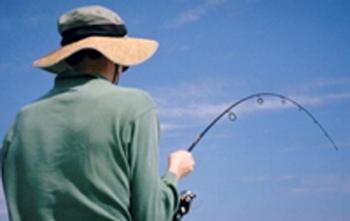
Before we go on, please note that the official term is "spine" - as in backbone. Not "spline" - as in gears and sprockets. Arrow spine refers to the arrow's degree of stiffness - how much the arrow resists being bent. Some arrows are very stiff, others are very limber. And if you ever intend to achieve serious accuracy with your compound bow, you'll need to choose an arrow that's just stiff enough - but not too stiff for your particular bow setup.
Most people think an arrow flies just like it looks when at rest - perfectly straight. But nothing could be further from the truth. Once fired from a bow, an arrow immediately begins flexing and oscillating. That's not a defect. Each arrow bends and flexes in a particular cycle as it leaves the bow (archer's paradox). If the timing of the cycle is correct, the tail of the arrow clears the bow without making contact with the arrow rest, riser, or cables. If the timing of the cycle is not correct due to improper arrow spine, the over- or under-oscillation of the arrow results in serious fletching contact and/or paper-tune tears which cannot be corrected. So we have to get this one right.
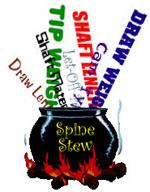
Determining Factors which Affect Arrow Spine
There are three main ingredients which determine an arrow shaft's general spine characteristics:
(1) the stiffness of the actual shaft material
(2) the length of the shaft
(3) the tip weight that will be used
But it's not quite as simple as 1-2-3. How stiff an arrow is when it's sitting still on the workbench, and when it's busy accelerating from 0-180 mph as it's fired from the bow, are totally different issues. When the arrow is at rest, we refer to it's stiffness characteristics as static spine. But when that same arrow is in motion, its stiffness is a matter of dynamic spine - which adds more ingredients into our consideration pot. So pay attention. This gets a little tricky.
Static Arrow Spine
If you support an arrow shaft at two points a given distance apart, then hang a weight in the middle of the arrow - the weight will cause the arrow shaft to sag. How much the shaft resists this type of bending would be a function of the arrow's static spine. The actual static spine of the arrow shaft is determined by the elasticity of the materials in the shaft and the geometry of the shaft. In multi-layered arrows (carbon/aluminum, etc.) the bonding materials also contribute to the static spine. The inside diameter, the cross-section shape, and the thickness of the material all contribute to the static spine of the shaft material. However, arrows don't perform under static conditions - like a floor joist or a curtain-rod. Arrows perform under dynamic conditions, with motion. A hanging weight doesn't really represent how forces are applied to arrows when they're actually shot, so static spine is really used as only a benchmark for predicting dynamic spine.
Dynamic Arrow Spine
Unless your arrow shaft breaks or is altered, its static spine remains the same throughout its life. But your arrow's dynamic spine can change dramatically depending on how it's used. The real mean-n-potatoes of arrow performance relies on the arrow's dynamic spine. The dynamic spine is how the arrow actually bends when shot - and there are many factors which affect the dynamic spine. The static spine of the shaft is only part of the equation. As you fire the arrow, the explosive force of the bow compresses the shaft and it momentarily bends under the strain. The more powerful the bow, the more the arrow bends. So the dynamic spine of two identical arrows, shot from two different bows of varying output, could be drastically different. If your arrow has the proper amount of dynamic spine when shot from your modern 70# hard-cam bow - its stiffness is just right - not too limber - not too stiff. But, if you take that same arrow and shoot it out of your son's 40# youth bow, it will be dramatically too stiff. The arrow will have too much dynamic spine. Likewise, if you shoot your son's arrows in your 70# bow, it's likely the arrows will be dramatically too limber - not enough dynamic spine. Determining a proper dynamic spine is a bit more complex and requires examination of several contributing factors.
Shaft Length Affects Dynamic Arrow Spine
When an arrow is fired it bends because it is effectively being compressed. The arrow is momentarily trapped between the forward motion of the string and the static load of the arrow's tip. And the longer the shaft is, the more easily this compressive force can bend it. Imagine a brand new pencil. If you put each end of the pencil between your palms and began compressing the pencil by squeezing your palms together, this would be similar to the forces that cause an arrow to bend when shot.

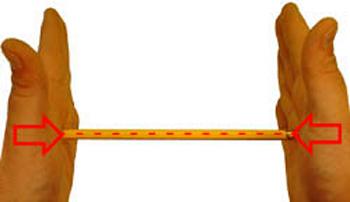
If you had two pencils, one standard length and one that was 2 ft. long, you would get very different results when you tried the compress them. A short pencil is surprisingly stiff and resists bending this way. But the long pencil would bend easily under the compressive load between your palms.
So although the shaft material (wood & pencil lead) would be the same for each of your tests, the shorter pencil would exhibit more spine stiffness - it would act stiffer. The longer pencil would exhibit less spine stiffness - it would act more limber. This is similar to how arrow length affects dynamic arrow spine. The shorter an arrow shaft is, the more dynamic spine stiffness it will exhibit under acceleration. The longer the arrow shaft, the less dynamic spine stiffness it exhibits under acceleration.
So if you change your arrow length, you must consider how that affects your arrow spine requirements.
Tip Weight Affects Dynamic Arrow Spine
Every arrow should have a tip. The tip is the business end of the arrow. It could be a simple steel practice point, a razor sharp hunting broadhead, a small-game judo tip, or a number of other tips designed for a variety of purposes. Each of these arrow tips is also designed to a specific grain weight. The most popular weights are 75gr, 85gr, 90gr, 100gr, and 125gr. However, some specialty tips can be much lighter or heavier.
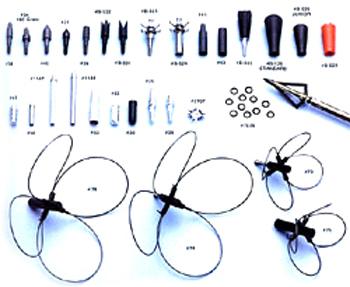
OK. Now remember how a bow compresses the arrow shaft? It's not hard to figure out what's pushing in one direction - the forward movement of the bow's string. That's an easy one. But what force pushes back the other direction? You can't get that kind of compression if you don't have two opposing forces - one pushing on each end of the shaft, right?
So what pushes on the other end? Oddly enough, it's the arrow's TIP. Of course, the tip doesn't actively do anything. It's just a weight - hanging out at the end of the shaft. But surely you must remember learning about Newton's Laws of Motion. Remember the one that says "an object at rest tends to stay at rest unless acted upon by a force?" Well think of it this way. The arrow's tip is the "object at rest," and the forward movement of the string is the "force." The stationary mass on the end of the arrow resists the forward motion of the string, and since the heavy tip of the arrow is where most of the arrow's mass is concentrated, that's the area of the arrow that resists the most. So the forward motion of the string and the resistance of the tip at rest create the opposing forces.
So, the greater the tip weight, the greater the compression (and flexing) of the arrow shaft when it's shot. The lighter the tip, the lesser the compression (and flexing) of the arrow shaft when it's shot. So a heavy tip DECREASES an arrow's dynamic spine (makes it act more limber). A lighter tip INCREASES an arrow's dynamic spine (makes it act more stiff).
This idea is a bit more abstract, so consider a final dramatic example to illustrate the concept. Imagine if you screwed a bowling ball on the end of an arrow and tried to shoot it. Upon firing the bow, the arrow shaft would compress between the forward motion of the string and the bowling ball. The arrow would bend dramatically as the bowling ball started to grudgingly inch forward. This would be an extreme example of how a heavy tip would reduce the arrow's dynamic spine. So remember, lighter tips make an arrow act more stiff. Heavier tips make an arrow act more limber.
Macho-Man Checkpoint
In sections #4-5, we'll discuss the topic of tip weight selection and explore its effects on arrow mass, front-of-center balance, loss of shot trajectory, and kinetic energy in greater detail. But for now, it's worth noting that some archers are hopelessly stricken by the Macho-Man Syndrome when it comes to choosing arrows and arrow tips. Some guys simply cannot dispense with the macho idea that bigger is better. We assure you, bigger is not necessarily better - at least not when it comes to selecting arrows and arrow components.
Choosing an excessively stiff arrow shaft and/or an excessively heavy arrow tip will likely yield no benefit whatsoever to most bow hunters. In fact, MMS sufferers are often at a technical disadvantage to other bow hunters with proper setups. With today's hot new compound bows often pumping out 60, 70, even 80+ ft-lbs of kinetic energy, much of the "old school" thinking about hefty arrow mass and heavy tip weights is no longer applicable. If you absolutely must supersize some part of your bow hunting gear, get an extra big bow case. But get arrows that actually fit your bow.
Bow Output Affects Dynamic Arrow Spine
The physical features of the arrow (the shaft's static spine, the shaft length, and the arrow's tip weight) all play a part in giving the arrow its spine characteristics. But as we mentioned earlier, the arrows final dynamic spine (how much it will actually flex when shot) will also depend greatly on the output of the bow. Your draw weight, draw length, cam-type, let-off percentage, and bow efficiency all contribute to the actual output of the bow. And bows with more powerful outputs will require stiffer arrows to achieve the proper dynamic spine when shot. Bows with less powerful output will require more limber shafts.
Fortunately, the engineers have already crunched the numbers for us on their spine selection charts. But before we go to the charts, you should understand which attributes affect the output of a bow and the spine requirements of the arrow. Most arrow manufacturers publish charts which take some, or all, of these bow output factors into account when recommending a particular arrow spine size.

Basic Arrow Spine Application Charts
Some arrow manufacturers have very complex charts that take many variables into account. But other arrow manufacturers offer a more simplified chart with an arbitrary number system, like the sample chart on the right which just references draw weight and arrow length. If you go by the simple chart method, then you'll need to apply a little common sense if your particular bow setup isn't exactly "average." For example, if you shoot a typical 310 fps compound bow, with normal 100 gr tips, and 75% let-off, all you'll need to do is follow the chart. If your bow is set for 60# and you use 29" arrows, you just follow the dots on the chart and choose the 2000 spine size. Easy!
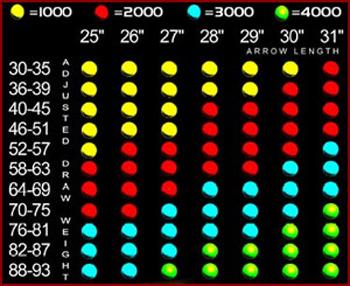
But what if you shoot a very aggressive speed-bow with an IBO speed over 340 fps ... say a PSE X-Force or a Bowtech Destroyer 350? In that case, your bow will have more output than an average 60# bow, so you would need to accommodate by choosing a little stiffer spine like the 3000 shaft. So be prepared to use your best judgment, should your bow setup have some special characteristic that needs extra consideration.
If you would rather not use the simplified method, then we suggest you get to know the concept of actual spine deflection.
Spine Deflection Measurements
Sometimes an arrow's spine stiffness is expressed as a more technical measurement, called a spine deflection. According to the modern standards (ASTM F2031-05) an arrow's official spine deflection is measured by hanging a 1.94 lb. weight in the center of a 28" suspended section of the arrow shaft (not to be confused with the old AMO standard of 2 lb. and 26"). The actual distance the 1.94 lb. weight causes the shaft to sag down is the arrow's actual spine deflection. For example, if a 1.94 lb. weight causes the center of a 28" arrow to sag down 1/2 inch (.500"). Then the arrow's spine deflection would be .500". Stiffer arrows will, of course, sag less. More limber arrows will sag more. So the stiffer the arrow is, the LOWER its spine deflection measurement will be. The more limber an arrow is, the HIGHER its spine deflection measurement will be.
Spine Consistency
Remember how we mentioned the cut-throat squabble about arrow straightness? Well, the same is true for spine consistency. If you test for spine deflection while slowly rotating the arrow, the spine deflection should remain constant. No matter which direction you bend the shaft, it should be equally resistant at all points, right? Nope! The wound layers of a carbon arrow will often have a seam somewhere inside the circle. This creates an imbalance in the spine consistency of the arrow, such that the arrow is a bit more stiff at one point around the circle. It's unfortunate, but the process by which carbon arrows are manufactured inevitably results in some imperfections. And if you want to get really technical, most arrow shafts aren't even perfectly round for that matter.
But the important question is, does it really make a difference? From a pure physics standpoint, yes. But again, few shooters have enough skill to notice. Small amounts of spine variance are realistically inconsequential to the weekend bow hunter and backyard enthusiast. But that doesn't stop the arrow companies from bickering about who has the best spine consistency and accusing each other of spine crimes. After all, every arrow company wants YOU to believe that their arrows will give you a technical advantage ... even if that's a little distortion of the truth. Again, we'll avoid the internal melee here by not pointing fingers, but if you wish to know more about spine variance, check the forums. There are a few forum regulars out there who own spine testing devices and Hooter Shooters. And they'll be happy to disagree with us on this issue.
Using Spine Deflection Measurements to Select Published Arrow Sizes
OK! Let's choose an arrow spine! We strongly suggest you learn this system, as using actual spine deflection data is the only universal system for comparing arrow spines from model to model and manufacturer to manufacturer. The next section is technically exhaustive, but worth the read. Once you know about spine deflections measurements, picking arrow shafts will be easy from now on.
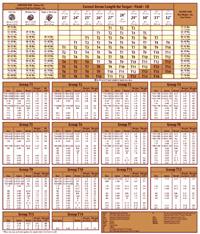
To understand the issue of arrow spine deflections and why they matter, you must understand something about the history of the arrow industry. The gold standard for rating arrow spine has always been Easton's fitment charts. Before carbon arrows hit their stride in the 1990's, practically every archer in the world had at one time studied the little blocks on the Easton chart, trying to decide if the 2219's, 2413's, or 2315's would be better (remember?). The basic rating system wasn't really hard to understand. The first two numbers were the arrow's diameter (in x/64th's of an inch) and the second two numbers were the shaft's wall thickness (in x/1,000th's of an inch). So a 2315 was an arrow shaft with a 23/64" diameter and a wall thickness of .015". Easy enough. But what did that really mean? The rating system had nothing to do with arrow spine, directly anyway, and the numbering system wasn't necessarily sequential. A 2315 arrow was actually heavier and stiffer than a 2413 arrow. A 2219 was surprisingly heavier than a 2512, but not as stiff. And a 2314 and a 2315 oddly weighed the same but had different deflections. Ok. So it wasn't so easy. But Easton's engineers crunched all the numbers and the handy aluminum arrow charts solved all the woes with their nice little organized blocks.
Then carbon arrows came along and made things easier ... almost. Since carbon arrows had a much broader ranger of application, there was no need for 10 to 15 sizes of the same arrow. For most carbon arrows, 3 to 5 sizes covers virtually every application. So Easton simplified the sizing system by basing the sizes on actual spine deflections. Easton's familiar carbon arrow spine sizing system (500, 400, 340, 300) is basically the arrow's spine deflection x1000. So a 500 shaft is a .500" deflection. A 340 Easton shaft is a .340" deflection ... and so on. So forgiving the shift of the decimal, the Easton spine sizing system matches up nicely with actual spine deflections.
Unfortunately, the system is somewhat counterintuitive. For Easton/Beman arrows, the lower numbered shafts are actually the stiffer heavier shafts, and the higher numbered shafts are the more limber and lighter shafts. This naturally goes against the bigger is more line of thinking. Since most people don't know how spine deflections are obtained, or why they matter, some archers will simply buy the "larger" size for heavier bows and "smaller" sizes for lighter bows. Of course, this is completely backwards. So everyone ended up back at the Easton charts studying the little blocks. And why not? No archery pro-shop is complete without a big Easton chart on the wall. So why mess with tradition?
Turns out, Easton wasn't the only player in the carbon arrow game. In fact, they were one of the last to join-in when they purchased Beman in 1995. By that time, Gold Tip already had a five year head start with their popular graphite arrows. And Gold Tip had really simplified things with an easy 3 size system ... the famous 3555, 5575, and 7595. The system was intended to be self-explanatory. The 3555 roughly fit a 35-55# bow, a 5575 fit a 55-75# bow, and a 7595 fit a 75-95# bow. At least that's how most archers understood the sizing. But it didn't always work out. The Gold Tip arrows had spine deflections of .500" (3555), .400" (5575), and .340" (7595) respectively. So for example, a 53# bow shooting a 30" arrow actually required the 5575 spine (per the Easton gold standards anyway) instead of the 3555 that Gold Tip's sizing convention might suggest. So it wasn't long until Gold Tip published their own charts (yes, with the little blocks), based essentially on the Easton spine deflection data.
To be fair, Gold Tip's system really wasn't so bad ... comparatively anyway. There was worse to come. Not to be outdone, Carbon Force Arrows, a division of PSE, decided to really simplify things and make their sizes completely sequential ... 100, 200, 300, and 400. So the larger the number, the heavier and stiffer the arrow. Fine! But this scrambled all of our brains even worse because their arbitrary sizes actually overlapped the actual arrow deflections. The Carbon Force 100 has a .500" spine, the 200 has a .400" spine, the 300 has a .340" spine, and the 400 has a .300" spine. Try to wrap your noodle around that!
And just as our grey matter started to congeal from Carbon Force, Carbon Express reinvented their generally understandable 30/50, 45/60, 60/75 system (similar to Gold Tip's system but with the same drawbacks) to a system that's not just arbitrarily sequential (150, 250, 350), but varies from shaft to shaft. Their Maxima 250, for example, has a spine deflection of .404", but the Maxima Hunter (camo) 250 has a spine deflection of .417". Oh boy!
It boils down to this. Whether you like Easton arrows or not, Easton is the big dog in the arrow market (biggest by far). And Easton's competitors don't want to be seen as "copycatting" Easton by following Easton's sizing format. They want to be unique and develop their own marketing and sizing system for their products ... even if it ultimately leaves us all confused. There are well over a dozen popular carbon arrow manufacturers who sell carbon arrows in the U.S., and all of them are trying to sing their own tune. For archery enthusiasts this is both good and bad. Competition and innovation will continue to keep prices low and product quality high, but we'll all have to continue to put our thinking caps on when we shop for arrows. There are no universally agreed spine sizes among the various arrow manufacturers.
But the system of actual spine deflection is universal, because those measurements are guided by industry standards. That's the only apples-to-apples system that applies to every brand and model of carbon arrow. As long as the various carbon arrow manufacturers provide their spine deflection data (and they test using the industry standard method), manufacturers can size and market their arrows by any system they like ... and we can still reference the proper application to the gold standard Easton charts using actual spine deflections (see below).
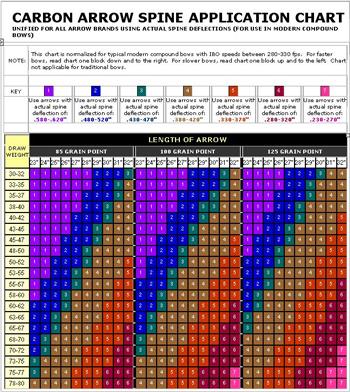
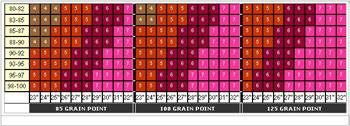
Jon Henry is an avid outdoorsman who enjoys both hunting and fishing. He has been shooting and competing in archery for almost 40 years, and began competitive archery in the NFAA at age 12 as a youth. He was a sponsored PAA pro archer for several years, and before that competed for 15 years in both the NFAA and NAA. Jon retired from competition about 8 years ago, due to a series of shoulder injuries that impacted my ability to sustain competitive performance.
Jon is in his mid 50's, and still very much enjoys shooting his bow and now crossbows as well. He is taking a great deal of his experience gained from building and tuning archery equipment and applying it to crossbow shooting, since they are very similar in many respects.
Jon's goal is to help as many new shooters gain a solid knowledge of their equipment as possible, so that we can continue to grow the sport of target shooting and hunting with a crossbow, until it becomes as popular as the other traditional forms of archery.
By Jon Henry
Arrow Spine - the 'Backbone' of the Arrow
If you've ever gone fishing, you probably already understand this concept. A fishing pole shouldn't be too limber or too stiff. You wouldn't take your heavyweight fishing-rod when you go Bluegill and Perch fishing? It's simply too stiff for the job and would perform poorly. A stiff rod doesn't cast light baits very well, and dragging in small pan fish on a heavyweight rod would be no fun anyway. On the other hand, you wouldn't dare take your ultra-lite fishing-rod for an afternoon of Florida Tarpon fishing. The ultra-lite rod wouldn't be stiff enough to fight such large fish, and it might even break if you hooked a good one. Right? For arrow selection, the concept is essentially the same - the arrow must have the appropriate strength and stiffness for the task - not too stiff - not too limber.

Before we go on, please note that the official term is "spine" - as in backbone. Not "spline" - as in gears and sprockets. Arrow spine refers to the arrow's degree of stiffness - how much the arrow resists being bent. Some arrows are very stiff, others are very limber. And if you ever intend to achieve serious accuracy with your compound bow, you'll need to choose an arrow that's just stiff enough - but not too stiff for your particular bow setup.
Most people think an arrow flies just like it looks when at rest - perfectly straight. But nothing could be further from the truth. Once fired from a bow, an arrow immediately begins flexing and oscillating. That's not a defect. Each arrow bends and flexes in a particular cycle as it leaves the bow (archer's paradox). If the timing of the cycle is correct, the tail of the arrow clears the bow without making contact with the arrow rest, riser, or cables. If the timing of the cycle is not correct due to improper arrow spine, the over- or under-oscillation of the arrow results in serious fletching contact and/or paper-tune tears which cannot be corrected. So we have to get this one right.

Determining Factors which Affect Arrow Spine
There are three main ingredients which determine an arrow shaft's general spine characteristics:
(1) the stiffness of the actual shaft material
(2) the length of the shaft
(3) the tip weight that will be used
But it's not quite as simple as 1-2-3. How stiff an arrow is when it's sitting still on the workbench, and when it's busy accelerating from 0-180 mph as it's fired from the bow, are totally different issues. When the arrow is at rest, we refer to it's stiffness characteristics as static spine. But when that same arrow is in motion, its stiffness is a matter of dynamic spine - which adds more ingredients into our consideration pot. So pay attention. This gets a little tricky.
Static Arrow Spine
If you support an arrow shaft at two points a given distance apart, then hang a weight in the middle of the arrow - the weight will cause the arrow shaft to sag. How much the shaft resists this type of bending would be a function of the arrow's static spine. The actual static spine of the arrow shaft is determined by the elasticity of the materials in the shaft and the geometry of the shaft. In multi-layered arrows (carbon/aluminum, etc.) the bonding materials also contribute to the static spine. The inside diameter, the cross-section shape, and the thickness of the material all contribute to the static spine of the shaft material. However, arrows don't perform under static conditions - like a floor joist or a curtain-rod. Arrows perform under dynamic conditions, with motion. A hanging weight doesn't really represent how forces are applied to arrows when they're actually shot, so static spine is really used as only a benchmark for predicting dynamic spine.
Dynamic Arrow Spine
Unless your arrow shaft breaks or is altered, its static spine remains the same throughout its life. But your arrow's dynamic spine can change dramatically depending on how it's used. The real mean-n-potatoes of arrow performance relies on the arrow's dynamic spine. The dynamic spine is how the arrow actually bends when shot - and there are many factors which affect the dynamic spine. The static spine of the shaft is only part of the equation. As you fire the arrow, the explosive force of the bow compresses the shaft and it momentarily bends under the strain. The more powerful the bow, the more the arrow bends. So the dynamic spine of two identical arrows, shot from two different bows of varying output, could be drastically different. If your arrow has the proper amount of dynamic spine when shot from your modern 70# hard-cam bow - its stiffness is just right - not too limber - not too stiff. But, if you take that same arrow and shoot it out of your son's 40# youth bow, it will be dramatically too stiff. The arrow will have too much dynamic spine. Likewise, if you shoot your son's arrows in your 70# bow, it's likely the arrows will be dramatically too limber - not enough dynamic spine. Determining a proper dynamic spine is a bit more complex and requires examination of several contributing factors.
Shaft Length Affects Dynamic Arrow Spine
When an arrow is fired it bends because it is effectively being compressed. The arrow is momentarily trapped between the forward motion of the string and the static load of the arrow's tip. And the longer the shaft is, the more easily this compressive force can bend it. Imagine a brand new pencil. If you put each end of the pencil between your palms and began compressing the pencil by squeezing your palms together, this would be similar to the forces that cause an arrow to bend when shot.


If you had two pencils, one standard length and one that was 2 ft. long, you would get very different results when you tried the compress them. A short pencil is surprisingly stiff and resists bending this way. But the long pencil would bend easily under the compressive load between your palms.
So although the shaft material (wood & pencil lead) would be the same for each of your tests, the shorter pencil would exhibit more spine stiffness - it would act stiffer. The longer pencil would exhibit less spine stiffness - it would act more limber. This is similar to how arrow length affects dynamic arrow spine. The shorter an arrow shaft is, the more dynamic spine stiffness it will exhibit under acceleration. The longer the arrow shaft, the less dynamic spine stiffness it exhibits under acceleration.
So if you change your arrow length, you must consider how that affects your arrow spine requirements.
Tip Weight Affects Dynamic Arrow Spine
Every arrow should have a tip. The tip is the business end of the arrow. It could be a simple steel practice point, a razor sharp hunting broadhead, a small-game judo tip, or a number of other tips designed for a variety of purposes. Each of these arrow tips is also designed to a specific grain weight. The most popular weights are 75gr, 85gr, 90gr, 100gr, and 125gr. However, some specialty tips can be much lighter or heavier.

OK. Now remember how a bow compresses the arrow shaft? It's not hard to figure out what's pushing in one direction - the forward movement of the bow's string. That's an easy one. But what force pushes back the other direction? You can't get that kind of compression if you don't have two opposing forces - one pushing on each end of the shaft, right?
So what pushes on the other end? Oddly enough, it's the arrow's TIP. Of course, the tip doesn't actively do anything. It's just a weight - hanging out at the end of the shaft. But surely you must remember learning about Newton's Laws of Motion. Remember the one that says "an object at rest tends to stay at rest unless acted upon by a force?" Well think of it this way. The arrow's tip is the "object at rest," and the forward movement of the string is the "force." The stationary mass on the end of the arrow resists the forward motion of the string, and since the heavy tip of the arrow is where most of the arrow's mass is concentrated, that's the area of the arrow that resists the most. So the forward motion of the string and the resistance of the tip at rest create the opposing forces.
So, the greater the tip weight, the greater the compression (and flexing) of the arrow shaft when it's shot. The lighter the tip, the lesser the compression (and flexing) of the arrow shaft when it's shot. So a heavy tip DECREASES an arrow's dynamic spine (makes it act more limber). A lighter tip INCREASES an arrow's dynamic spine (makes it act more stiff).
This idea is a bit more abstract, so consider a final dramatic example to illustrate the concept. Imagine if you screwed a bowling ball on the end of an arrow and tried to shoot it. Upon firing the bow, the arrow shaft would compress between the forward motion of the string and the bowling ball. The arrow would bend dramatically as the bowling ball started to grudgingly inch forward. This would be an extreme example of how a heavy tip would reduce the arrow's dynamic spine. So remember, lighter tips make an arrow act more stiff. Heavier tips make an arrow act more limber.
Macho-Man Checkpoint
In sections #4-5, we'll discuss the topic of tip weight selection and explore its effects on arrow mass, front-of-center balance, loss of shot trajectory, and kinetic energy in greater detail. But for now, it's worth noting that some archers are hopelessly stricken by the Macho-Man Syndrome when it comes to choosing arrows and arrow tips. Some guys simply cannot dispense with the macho idea that bigger is better. We assure you, bigger is not necessarily better - at least not when it comes to selecting arrows and arrow components.
Choosing an excessively stiff arrow shaft and/or an excessively heavy arrow tip will likely yield no benefit whatsoever to most bow hunters. In fact, MMS sufferers are often at a technical disadvantage to other bow hunters with proper setups. With today's hot new compound bows often pumping out 60, 70, even 80+ ft-lbs of kinetic energy, much of the "old school" thinking about hefty arrow mass and heavy tip weights is no longer applicable. If you absolutely must supersize some part of your bow hunting gear, get an extra big bow case. But get arrows that actually fit your bow.
Bow Output Affects Dynamic Arrow Spine
The physical features of the arrow (the shaft's static spine, the shaft length, and the arrow's tip weight) all play a part in giving the arrow its spine characteristics. But as we mentioned earlier, the arrows final dynamic spine (how much it will actually flex when shot) will also depend greatly on the output of the bow. Your draw weight, draw length, cam-type, let-off percentage, and bow efficiency all contribute to the actual output of the bow. And bows with more powerful outputs will require stiffer arrows to achieve the proper dynamic spine when shot. Bows with less powerful output will require more limber shafts.
Fortunately, the engineers have already crunched the numbers for us on their spine selection charts. But before we go to the charts, you should understand which attributes affect the output of a bow and the spine requirements of the arrow. Most arrow manufacturers publish charts which take some, or all, of these bow output factors into account when recommending a particular arrow spine size.

Basic Arrow Spine Application Charts
Some arrow manufacturers have very complex charts that take many variables into account. But other arrow manufacturers offer a more simplified chart with an arbitrary number system, like the sample chart on the right which just references draw weight and arrow length. If you go by the simple chart method, then you'll need to apply a little common sense if your particular bow setup isn't exactly "average." For example, if you shoot a typical 310 fps compound bow, with normal 100 gr tips, and 75% let-off, all you'll need to do is follow the chart. If your bow is set for 60# and you use 29" arrows, you just follow the dots on the chart and choose the 2000 spine size. Easy!

But what if you shoot a very aggressive speed-bow with an IBO speed over 340 fps ... say a PSE X-Force or a Bowtech Destroyer 350? In that case, your bow will have more output than an average 60# bow, so you would need to accommodate by choosing a little stiffer spine like the 3000 shaft. So be prepared to use your best judgment, should your bow setup have some special characteristic that needs extra consideration.
If you would rather not use the simplified method, then we suggest you get to know the concept of actual spine deflection.
Spine Deflection Measurements
Sometimes an arrow's spine stiffness is expressed as a more technical measurement, called a spine deflection. According to the modern standards (ASTM F2031-05) an arrow's official spine deflection is measured by hanging a 1.94 lb. weight in the center of a 28" suspended section of the arrow shaft (not to be confused with the old AMO standard of 2 lb. and 26"). The actual distance the 1.94 lb. weight causes the shaft to sag down is the arrow's actual spine deflection. For example, if a 1.94 lb. weight causes the center of a 28" arrow to sag down 1/2 inch (.500"). Then the arrow's spine deflection would be .500". Stiffer arrows will, of course, sag less. More limber arrows will sag more. So the stiffer the arrow is, the LOWER its spine deflection measurement will be. The more limber an arrow is, the HIGHER its spine deflection measurement will be.
Spine Consistency
Remember how we mentioned the cut-throat squabble about arrow straightness? Well, the same is true for spine consistency. If you test for spine deflection while slowly rotating the arrow, the spine deflection should remain constant. No matter which direction you bend the shaft, it should be equally resistant at all points, right? Nope! The wound layers of a carbon arrow will often have a seam somewhere inside the circle. This creates an imbalance in the spine consistency of the arrow, such that the arrow is a bit more stiff at one point around the circle. It's unfortunate, but the process by which carbon arrows are manufactured inevitably results in some imperfections. And if you want to get really technical, most arrow shafts aren't even perfectly round for that matter.
But the important question is, does it really make a difference? From a pure physics standpoint, yes. But again, few shooters have enough skill to notice. Small amounts of spine variance are realistically inconsequential to the weekend bow hunter and backyard enthusiast. But that doesn't stop the arrow companies from bickering about who has the best spine consistency and accusing each other of spine crimes. After all, every arrow company wants YOU to believe that their arrows will give you a technical advantage ... even if that's a little distortion of the truth. Again, we'll avoid the internal melee here by not pointing fingers, but if you wish to know more about spine variance, check the forums. There are a few forum regulars out there who own spine testing devices and Hooter Shooters. And they'll be happy to disagree with us on this issue.
Using Spine Deflection Measurements to Select Published Arrow Sizes
OK! Let's choose an arrow spine! We strongly suggest you learn this system, as using actual spine deflection data is the only universal system for comparing arrow spines from model to model and manufacturer to manufacturer. The next section is technically exhaustive, but worth the read. Once you know about spine deflections measurements, picking arrow shafts will be easy from now on.

To understand the issue of arrow spine deflections and why they matter, you must understand something about the history of the arrow industry. The gold standard for rating arrow spine has always been Easton's fitment charts. Before carbon arrows hit their stride in the 1990's, practically every archer in the world had at one time studied the little blocks on the Easton chart, trying to decide if the 2219's, 2413's, or 2315's would be better (remember?). The basic rating system wasn't really hard to understand. The first two numbers were the arrow's diameter (in x/64th's of an inch) and the second two numbers were the shaft's wall thickness (in x/1,000th's of an inch). So a 2315 was an arrow shaft with a 23/64" diameter and a wall thickness of .015". Easy enough. But what did that really mean? The rating system had nothing to do with arrow spine, directly anyway, and the numbering system wasn't necessarily sequential. A 2315 arrow was actually heavier and stiffer than a 2413 arrow. A 2219 was surprisingly heavier than a 2512, but not as stiff. And a 2314 and a 2315 oddly weighed the same but had different deflections. Ok. So it wasn't so easy. But Easton's engineers crunched all the numbers and the handy aluminum arrow charts solved all the woes with their nice little organized blocks.
Then carbon arrows came along and made things easier ... almost. Since carbon arrows had a much broader ranger of application, there was no need for 10 to 15 sizes of the same arrow. For most carbon arrows, 3 to 5 sizes covers virtually every application. So Easton simplified the sizing system by basing the sizes on actual spine deflections. Easton's familiar carbon arrow spine sizing system (500, 400, 340, 300) is basically the arrow's spine deflection x1000. So a 500 shaft is a .500" deflection. A 340 Easton shaft is a .340" deflection ... and so on. So forgiving the shift of the decimal, the Easton spine sizing system matches up nicely with actual spine deflections.
Unfortunately, the system is somewhat counterintuitive. For Easton/Beman arrows, the lower numbered shafts are actually the stiffer heavier shafts, and the higher numbered shafts are the more limber and lighter shafts. This naturally goes against the bigger is more line of thinking. Since most people don't know how spine deflections are obtained, or why they matter, some archers will simply buy the "larger" size for heavier bows and "smaller" sizes for lighter bows. Of course, this is completely backwards. So everyone ended up back at the Easton charts studying the little blocks. And why not? No archery pro-shop is complete without a big Easton chart on the wall. So why mess with tradition?
Turns out, Easton wasn't the only player in the carbon arrow game. In fact, they were one of the last to join-in when they purchased Beman in 1995. By that time, Gold Tip already had a five year head start with their popular graphite arrows. And Gold Tip had really simplified things with an easy 3 size system ... the famous 3555, 5575, and 7595. The system was intended to be self-explanatory. The 3555 roughly fit a 35-55# bow, a 5575 fit a 55-75# bow, and a 7595 fit a 75-95# bow. At least that's how most archers understood the sizing. But it didn't always work out. The Gold Tip arrows had spine deflections of .500" (3555), .400" (5575), and .340" (7595) respectively. So for example, a 53# bow shooting a 30" arrow actually required the 5575 spine (per the Easton gold standards anyway) instead of the 3555 that Gold Tip's sizing convention might suggest. So it wasn't long until Gold Tip published their own charts (yes, with the little blocks), based essentially on the Easton spine deflection data.
To be fair, Gold Tip's system really wasn't so bad ... comparatively anyway. There was worse to come. Not to be outdone, Carbon Force Arrows, a division of PSE, decided to really simplify things and make their sizes completely sequential ... 100, 200, 300, and 400. So the larger the number, the heavier and stiffer the arrow. Fine! But this scrambled all of our brains even worse because their arbitrary sizes actually overlapped the actual arrow deflections. The Carbon Force 100 has a .500" spine, the 200 has a .400" spine, the 300 has a .340" spine, and the 400 has a .300" spine. Try to wrap your noodle around that!
And just as our grey matter started to congeal from Carbon Force, Carbon Express reinvented their generally understandable 30/50, 45/60, 60/75 system (similar to Gold Tip's system but with the same drawbacks) to a system that's not just arbitrarily sequential (150, 250, 350), but varies from shaft to shaft. Their Maxima 250, for example, has a spine deflection of .404", but the Maxima Hunter (camo) 250 has a spine deflection of .417". Oh boy!
It boils down to this. Whether you like Easton arrows or not, Easton is the big dog in the arrow market (biggest by far). And Easton's competitors don't want to be seen as "copycatting" Easton by following Easton's sizing format. They want to be unique and develop their own marketing and sizing system for their products ... even if it ultimately leaves us all confused. There are well over a dozen popular carbon arrow manufacturers who sell carbon arrows in the U.S., and all of them are trying to sing their own tune. For archery enthusiasts this is both good and bad. Competition and innovation will continue to keep prices low and product quality high, but we'll all have to continue to put our thinking caps on when we shop for arrows. There are no universally agreed spine sizes among the various arrow manufacturers.
But the system of actual spine deflection is universal, because those measurements are guided by industry standards. That's the only apples-to-apples system that applies to every brand and model of carbon arrow. As long as the various carbon arrow manufacturers provide their spine deflection data (and they test using the industry standard method), manufacturers can size and market their arrows by any system they like ... and we can still reference the proper application to the gold standard Easton charts using actual spine deflections (see below).


Jon Henry is an avid outdoorsman who enjoys both hunting and fishing. He has been shooting and competing in archery for almost 40 years, and began competitive archery in the NFAA at age 12 as a youth. He was a sponsored PAA pro archer for several years, and before that competed for 15 years in both the NFAA and NAA. Jon retired from competition about 8 years ago, due to a series of shoulder injuries that impacted my ability to sustain competitive performance.
Jon is in his mid 50's, and still very much enjoys shooting his bow and now crossbows as well. He is taking a great deal of his experience gained from building and tuning archery equipment and applying it to crossbow shooting, since they are very similar in many respects.
Jon's goal is to help as many new shooters gain a solid knowledge of their equipment as possible, so that we can continue to grow the sport of target shooting and hunting with a crossbow, until it becomes as popular as the other traditional forms of archery.

